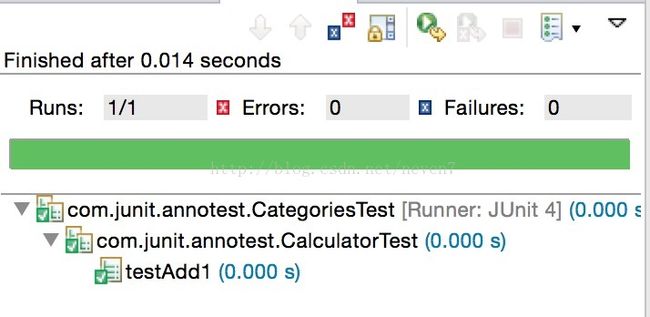JUnit4--- @Annotation注解总结
总结一下JUnit4中常用的注解:
1.@RunWith:一个类添加@RunWith或继承的父类添加@RunWith时,JUnit会调用@RunWith使用指定的自定义Runner来执行该类中的测试方法,而不是JUnit4中固定的Runner。
Runner就是用来执行测试用例并通知给RunNotifier执行测试用例的进展。
JUnit4默认的Runner为BlockJUnit4ClassRunner,当你在Eclipse中新建一个JUnit Test Case时,生成的class并未显示指定@RunWith,这时Runner为默认的BlockJUnit4ClassRunner。
java.lang.Object
org.junit.runner.Runner
org.junit.runners.ParentRunner<FrameworkMethod>
org.junit.runners.BlockJUnit4ClassRunner
常见的Runner有4类:
(1).Suite:执行指定多个类的测试方法。
java.lang.Object
org.junit.runner.Runner
org.junit.runners.ParentRunner<Runner>
org.junit.runners.Suite
如下,运行SuiteClassTest,会执行聚合ATest.class和BTest.class中所有的测试方法。
@RunWith(Suite.class)
@SuiteClasses({ATest.class, BTest.class})
public class SuiteClassTest{
}
(2).Parameterized:执行参数化测试。
java.lang.Object
org.junit.runner.Runner
org.junit.runners.ParentRunner<Runner>
org.junit.runners.Suite
org.junit.runners.Parameterized
(3).Theories:根据@DataPoint作为输入数据,执行测试方法。
java.lang.Object
org.junit.runner.Runner
org.junit.runners.ParentRunner<FrameworkMethod>
org.junit.runners.BlockJUnit4ClassRunner
org.junit.experimental.theories.Theories
(4).Categories:执行@IncludeCategory或其子类型的测试方法或类。
java.lang.Object
org.junit.runner.Runner
org.junit.runners.ParentRunner<Runner>
org.junit.runners.Suite
org.junit.experimental.categories.Categories
当然,还可以自定义Runner:
(5)RetryRunner:重试机制,淘测试中一篇文章:http://www.taobaotest.com/blogs/2373。
(6)ConcurrentSuite:使用线程池并发执行测试用例,另写文章介绍JUnit4的并发执行。
2.@Test:标记为测试方法。
注解成员有:(1)timeout=100ms,超时验证 (2)expected=异常class,抛出异常验证
3.@Ignore:忽略此测试方法。
4.@BeforeClass,在开始执行整个类的测试方法前,先执行一次该方法。申请资源等。
@AfterClass,在执行完整个类的测试方法后,执行一次该方法。释放资源等。
@Before,在执行整个类的每个测试方法前,执行一次该方法。
@After,在执行完整个类的每个测试方法后,执行一次该方法。
5.@FixMethodOrder,指定测试方法的顺序,
比如:@FixMethodOrder(MethodSorters.NAME_ASCENDING), 以方法名的字典序执行。MethodSortersm枚举类型:
DEFAULT Sorts the test methods in a deterministic, but not predictable, order |
JVM Leaves the test methods in the order returned by the JVM. |
NAME_ASCENDING Sorts the test methods by the method name, in lexicographic order, with Method.toString() used as a tiebreaker |
理论介绍完了,下面用实例来实践下。
1.被测类 Calculator.java
public class Calculator {
public double add(double num1, double num2) {
return num1 + num2;
}
public double minus(double num1, double num2) {
return num1 - num2;
}
public double multiply(double num1, double num2) {
// 死循环,模拟超时
int i = 0;
while (true) {
i++;
}
}
public double division(double num1, double num2) {
if(0.0 == num2){
throw new ArithmeticException("被除数不能为0");
}else{
return num1 / num2;
}
}
}
(一) JUnit测试类 CalculatorTest.java, 用到的注解有:@BeforeClass, @AfterClass, @Before, @After,@Test(timeout, expected元素), @Ignore, @Category
package com.junit.annotest;
import static org.junit.Assert.*;
import static org.hamcrest.Matchers.*;
import java.util.ArrayList;
import org.junit.After;
import org.junit.AfterClass;
import org.junit.Before;
import org.junit.BeforeClass;
import org.junit.Ignore;
import org.junit.Test;
import org.junit.experimental.categories.Category;
public class CalculatorTest {
public interface SmokeTests{
}
public interface SlowTests{
}
@BeforeClass
public static void setUpBeforeClass() throws Exception {
System.out.println("BeforeClass");
}
@AfterClass
public static void tearDownAfterClass() throws Exception {
System.out.println("AfterClass");
}
@Before
public void setUp() throws Exception {
System.out.println("Before");
}
@After
public void tearDown() throws Exception {
System.out.println("After");
}
public CalculatorTest(){
System.out.println("无参构造函数");
}
@Category(SmokeTests.class)
@Test
public void testAdd1() {
assertThat(3.64, is(new Calculator().add(3.14, 0.5)));
}
@Category(SlowTests.class)
@Test
public void testAdd2() throws Exception {
Thread.sleep(1000);
assertThat(1003.14, is(new Calculator().add(3.14, 1000)));
}
@Category(SlowTests.class)
@Test
public void testAdd3() throws Exception {
Thread.sleep(2000);
assertThat(2003.14, is(new Calculator().add(3.14, 2000)));
}
@Ignore
@Test
public void testMinus() {
assertThat(0.0, is(new Calculator().minus(3.14, 3.14)));
}
@Test(timeout=1000)
public void testMultiply() {
assertThat(3.14, is(new Calculator().multiply(3.14, 1.0)));
}
@Test(expected=ArithmeticException.class)
public void testDivision() {
new Calculator().division(3.14, 0.0);
}
}
Console下显示如下:可以看到,每次运行测试方法时,都会调用构造函数。
BeforeClass
无参构造函数
Before
After
无参构造函数
Before
After
无参构造函数
Before
After
无参构造函数
Before
After
无参构造函数
Before
After
AfterClass
testMultiply测试方法使用了@test(timeout=1000), 如果方法执行时间超过1000ms, 则该测试方法执行为Errors。
(二)CategoriesTest.java 使用了Categories Runner,执行分类的用例;@SuiteClasses指定特定的测试类;@IncludeCategory指定执行被标记分类(@Category(标记分类名.class))的测试类或方法。如下,
@IncludeCategory(SmokeTests.class)只运行
CalculatorTest.class中被标记为SmokeTests的测试方法:testAdd1(); @ExcludeCategory 不执行测试类或方法。
package com.junit.annotest;
import static org.junit.Assert.*;
import org.junit.AfterClass;
import org.junit.Test;
import org.junit.experimental.categories.Categories;
import org.junit.experimental.categories.Categories.IncludeCategory;
import org.junit.runner.RunWith;
import org.junit.runners.Suite.SuiteClasses;
import com.junit.annotest.CalculatorTest.SmokeTests;
@RunWith(Categories.class)
@SuiteClasses(CalculatorTest.class)
@IncludeCategory(SmokeTests.class)
public class CategoriesTest {
}
运行结果如下:
2. Runner: Parameterized,参数化执行用例。
被测类:Fibonacci.java
package com.junit.annotest;
public class Fibonacci {
// 根据index,获取Fibonacci数列的值
public int valueOfFib(int index){
if(0 == index){
return 0;
}else if(1 == index){
return 1;
}else{
return valueOfFib(index-2) + valueOfFib(index-1);
}
}
}
(一)使用带参构造函数获取数据集
@Parameters指定数据集,该注解下有个name成员,可以标注每个数据集成员的信息,index所在数据集索引,{n}每个数据集元素{...}的第n+1的值。被注解的方法返回数据集数组。运行测试方法时,通过带参构造函数,生成FibonacciTest实例,获取数据集成员,一组数据集对应执行一次。
package com.junit.annotest;
import static org.junit.Assert.*;
import static org.hamcrest.Matchers.*;
import java.util.Arrays;
import java.util.Iterator;
import java.util.List;
import org.junit.Test;
import org.junit.runner.RunWith;
import org.junit.runners.Parameterized;
import org.junit.runners.Parameterized.Parameters;
@RunWith(Parameterized.class)
public class FibonacciTest {
@Parameters(name="{index}:fib[{0}]={1}")
public static List<Object[]> data() {
return Arrays.asList(
new Object[][] { { 0, 0 }, { 1, 1 }, { 2, 1 }, { 3, 2 },
{ 4, 3 }, { 5, 5 }, { 8, 21 } });
}
private int index;
private int value;
public FibonacciTest(int index, int value) {
super();
this.index = index;
this.value = value;
}
@Test
public void testFib() {
assertThat(value, is(new Fibonacci().valueOfFib(index)));
}
}
运行结果:
(二)使用@Parameter(n)获取数据集
注意,这时类数据成员为public访问类型,并为数据成员指定@parameter(n),n表示该成员获取数据集中元素第n个值。
package com.junit.annotest;
import static org.hamcrest.Matchers.is;
import static org.junit.Assert.*;
import java.util.Arrays;
import java.util.List;
import org.junit.Test;
import org.junit.runner.RunWith;
import org.junit.runners.Parameterized;
import org.junit.runners.Parameterized.Parameter;
import org.junit.runners.Parameterized.Parameters;
@RunWith(Parameterized.class)
public class FibonacciTest2 {
@Parameters(name="{index}:fib[{0}]={1}")
public static List<Object[]> data(){
return Arrays.asList(new Object[][] { { 0, 0 }, { 1, 1 }, { 2, 1 }, { 3, 2 },
{ 4, 3 }, { 5, 5 }, { 8, 21 } });
}
@Parameter(0)
public int index;
@Parameter(1)
public int value;
@Test
public void testFib() {
assertThat(value, is(new Fibonacci().valueOfFib(index)));
}
}
运行结果:同上图。
3.Runner: Theories 通过@DataPoint(单个),@DataPoints(数组)指定数据集;@Theory指定测试方法,该方法带形参,获取前面@DataPoint或@DataPoints指定的数据。适合使用大量数据,进行测试。
package com.junit.annotest;
import static org.junit.Assert.*;
import static org.hamcrest.Matchers.*;
import org.junit.Test;
import org.junit.experimental.theories.DataPoint;
import org.junit.experimental.theories.DataPoints;
import org.junit.experimental.theories.Theories;
import org.junit.experimental.theories.Theory;
import org.junit.runner.RunWith;
@RunWith(Theories.class)
public class TheoriesTest {
@DataPoint
public static int num1 = 2;
@DataPoint
public static int num2 = 8;
@DataPoints
public static int[] num3 = {4, 5, 6, 7, 9};
@Theory
public void testFibon(int num) {
System.out.println(num);
assertThat(num,greaterThan(0));
}
}
测试结果如下:



